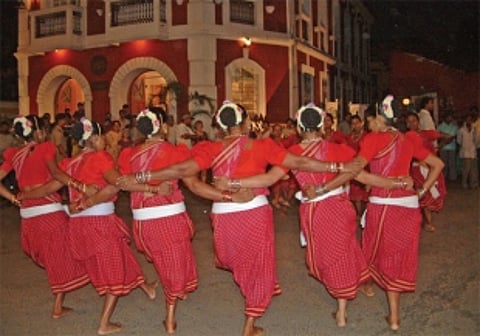

If Panjim, Ponje, Panaji is itself a work of art why does
it
need art and film festivals to give it the charm and grandeur. During IFFI,
Serendipity and other festivals, old venues are spruced up, charming spaces
come alive, the Adil Shah palace and the old PWD building become home for
artists, musicians poets and playwrights. The question is, Panjim doesn’t need
an occasion to be what it is. Occassions need Panjim
The people of Panjim, the authorities who run
it need to make one of the most beautiful towns in the world, a place where
creativity, charm, passion flows.
A lot of other festivals that were being held
earlier have been lost over the years. Once upon a time, a pre-carnival event
was always organized where people enjoyed throwing water balloons and painting
faces. A lot of people also lament the
famous Fontainhas festival of arts that no longer exists.
Pantaleo Fernandes an author and cultural
researcher shares light on how the Fontainhas festival of arts really portrayed
the culture of Goa when he visited it years ago, “The Festival of Arts at
Fontainhas was probably one of the first arts festival celebrated in Goa on
such a scale. The beauty of the event was that the organizers took into
confidence the local people who opened their hearts and their homes for the
festival. Almost every house turned into mini art galleries. I remember seeing
for the first time photographs printed on fine cloth. At another living room
there were portraits of the villages of Goa, another painter had vividly
painted images of Christ. The streets had become a live theatre – with
villagers from far corners of Goa bringing their folk dances alive.”
What has happened to Goa? Aren’t we going to
preserve our traditions and culture? If we ignore, then soon enough the famous
events like Samba Square activities and red and black dance will see days of
darkness, as people have already noticed how these things have been vastly
commercialized. Luckily, this year, Panjim had a chance of celebrating the
pre-carnival event - Asalto revived by Messis Tavares, the President for Grupo
Alegria, a Social and Cultural Association.
A Key to the Heritage and Cultural Venues of
Panjim
The founder of Soul Traveling Varun Hegde
seems to be aware that certain places are open to public, sometimes on request,
but with a requirement of regulations.
“Opening of places comes with certain
regulations; else it will all be a messy affair. I’m glad these places are
slowly opening up, and I believe this is the way to go where people will slowly
get used to these places being open and then can frequent them with time”, says
Hegde.
Similarly, Jack Sukhija the Partner of Panjim
Heritage Inn, agrees that opening up heritage places for people all around the
year is a good idea but revenue should be generated for the maintenance and
sustaining he buildings. “If these places are taken care of, no one minds
keeping it open for the public; we should have a certain kind of respect for
these preservative cultural buildings. We need to keep it lively, but an
overdose of anything isn’t helpful. So moving cautiously, but we need the
festivities”
Fontainhas has always been the attractive
Latin quarter of Panjim with tiny lanes and streets all across the area, the
same infrastructure if applied to the other inner roads in Panjim, can make it
a divine zone. In fact after asking a few people on their opinions on this,
most have said not to restrict the idea only in Panjim, but everywhere else in
Goa.
There are so many areas across Goa which
needs to have this kind of infrastructure and which will benefit the people
living there too.
According to Pantaleo, everything has its
period of rest and rejuvenation and Goa is no exception. We need to take time
off and ease pressure off the infrastructure for a while.
Whether to open all the heritage structures
constantly to performances or tourists depends on their demand. This has to be
thoroughly studied and incorporated into the tourism policy which can then
focus on specific areas and market them as niche segments.
And
above all, if Goans cannot work towards keeping Goan traditions
alive, even our cultural spaces will get
invaded and dominated by others.